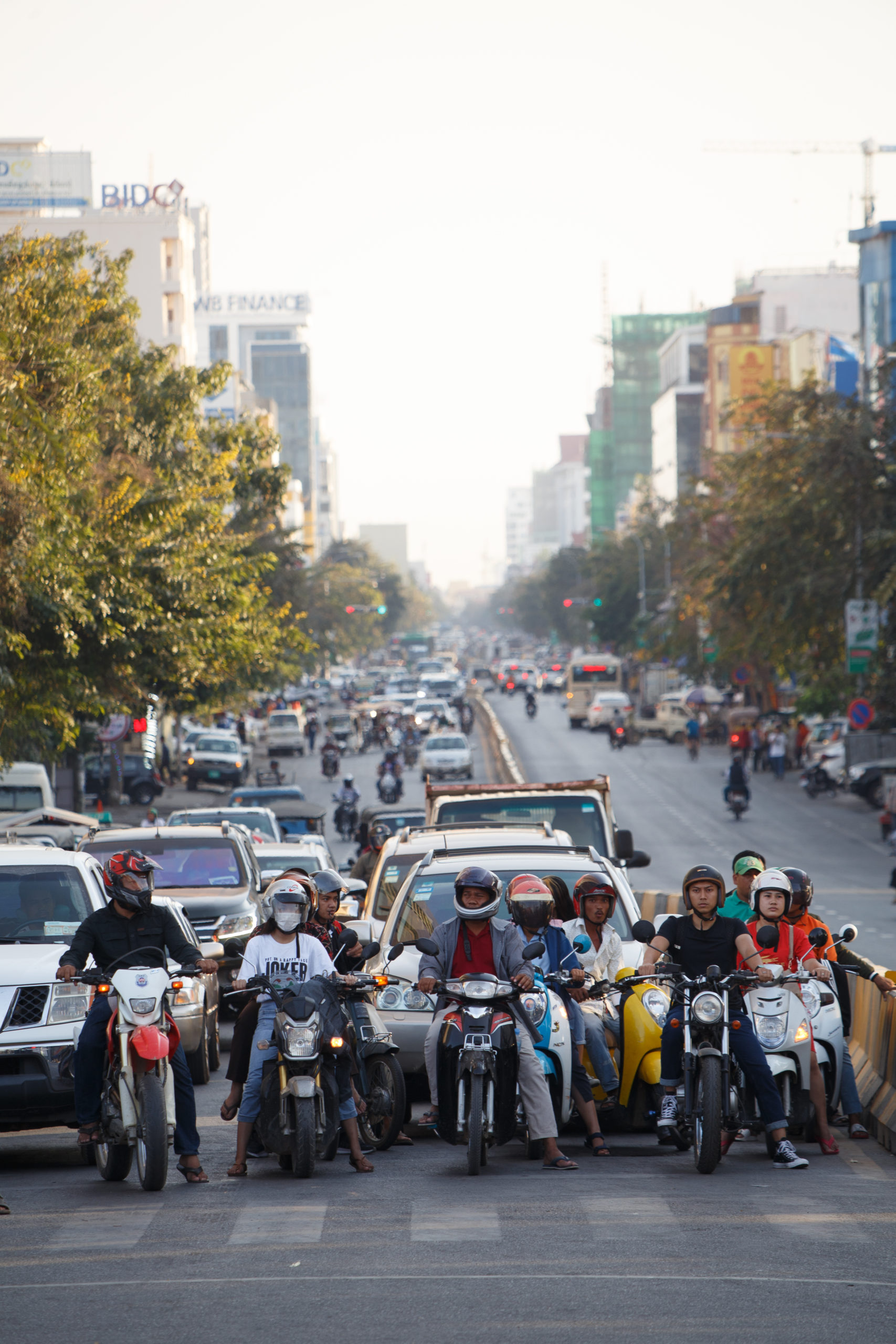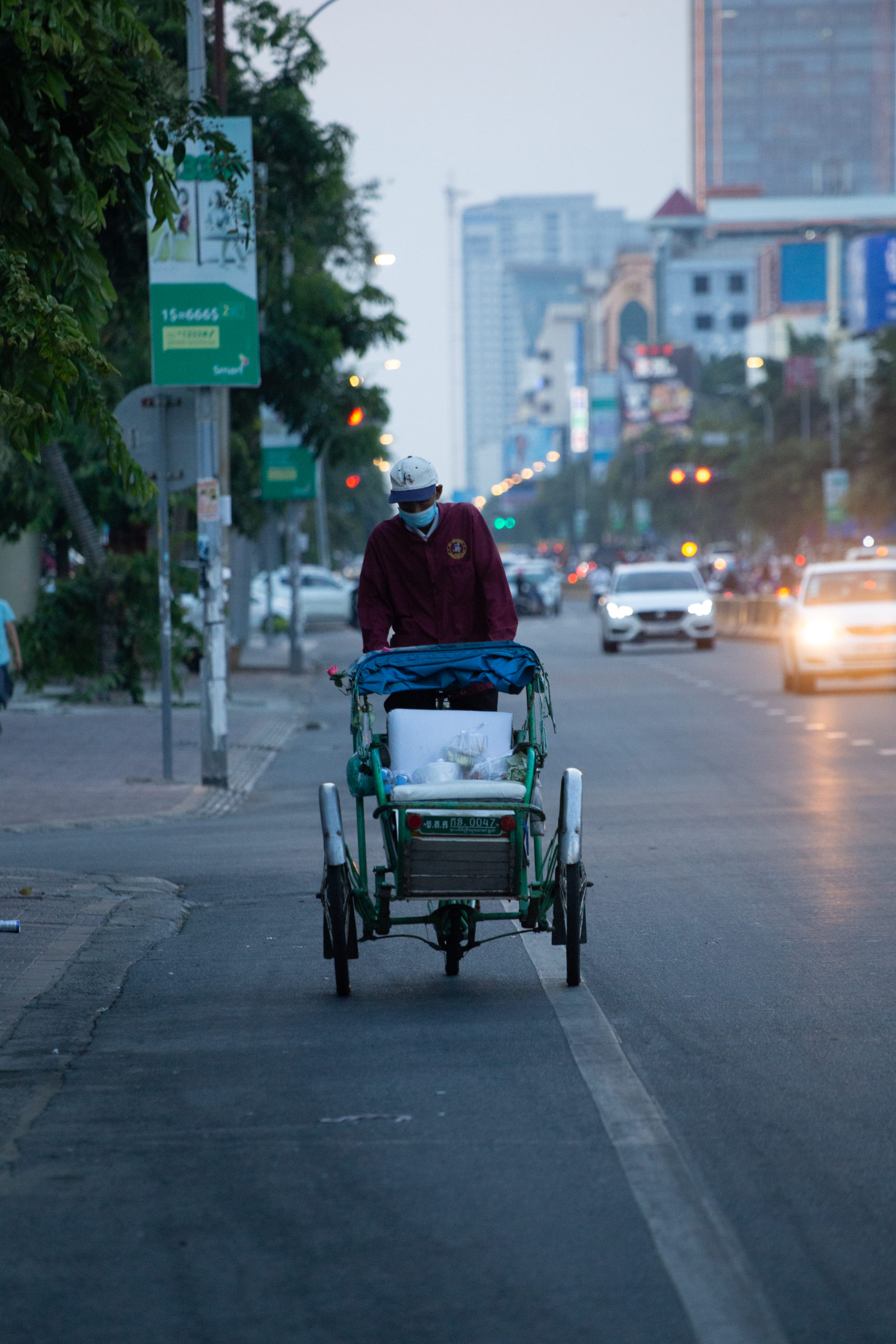Images by Phnom Penh-based photographer Shunsuke Miyatake
The mornings start early in Phnom Penh, the food stalls open for business tucked into allocated spaces along the road as a flow of cyclists and pedestrians begin the journey to work along tree-shaded paths and plazas.
As for the vehicles? They arrive in trickles, mostly transit buses, the occasional car and a handful of motorcycles. The dreaded rush hour wave never arrives.
While an appealing vision of the future, this is clearly not the reality today in Phnom Penh, a city which approaches urban planning from a car-centric perspective. Driven by the global ascendancy of automobiles after World War II, the car-centric city model encourages urban sprawl along city fringes, larger roads carving up neighbourhoods, elevated expressways cutting through historic urban centres and vast deserts of parking lots. It is a model which emphasises vehicles first and people second.
After decades of global adoption, the true costs and fundamental fallacy of such a model are only recently being understood. Worldwide, relentless urban sprawl has led to increasing costs to city halls and greater inconvenience and cost to commuters, all while compounding severe environmental damages. Additionally, despite cities spending billions to build and enhance vehicle infrastructure, traffic congestion has only become worse in the most car-dependent cities. Larger roads only create more traffic demand – and thus attract even more traffic. Phnom Penh is no different, with rush hour each day bringing with it major arteries going in and out of the city clogged with traffic.
But a better future could become a reality, even in a city like Phnom Penh, if we were to choose to adopt a new urban planning model. A model that is pedestrian-centric, cyclist-friendly, and transit-orientated, leaving behind the issues of a car-centric model. This vision may sound like a dream invented by idealistic Cambodian architects and planners, but these ideas are in fact already being implemented in many major cities around the world.

Removing and reducing roads will reduce traffic congestion
Leading the charge on re-envisioning what urban centres could look like are cities like Seoul and Madrid. Each formerly relied heavily on a car-centric approach, and have since moved away to pioneer more effective planning policies.
During South Korea’s economic rise of the 1980s, Seoul constructed multiple rounds of expressways cutting through its urban centre. By the beginning of the new millennium, these structures had become dilapidated and did little to alleviate Seoul’s ongoing problems with traffic congestion.
Seoul took drastic measures in 2003 by removing a full section of congested elevated highway from its central district. The expressway’s demolition revealed the long buried Cheonggyecheon stream – the namesake of the project.
Replacing the space once dominated by vehicles is a one hundred-acre, 5.8-kilometer urban park straddling the restored stream, flowing to the greater Han river. It is a lush and winding greenspace which has helped reduce heat in the immediate surrounding areas by 3.9 to 5.9 degrees celsius, has led to a reduction in air pollution by (35%), and has increased the area’s vegetation and marine biodiversity as well.
However, the most surprising benefits of this was a reduction in vehicle congestion in the city centre, and a marked increase in public transit ridership (15.1% for bus and 3.3% for subway respectively) for the central districts.
Additionally, the park’s accessibility increases connectivity between the formerly disconnected north and south districts, with the inclusion of bridges for pedestrians and vehicles. Bus transit lines were added to replace lost commute capacity, but the formerly sprawling ground-level driving lanes were greatly reduced to discourage personal vehicle usage, successfully reducing automobile trips around the central district areas.
Thus, paradoxically for Seoul, the solution to traffic issues was to minimise space and infrastructure which were exclusively reserved for cars. This counterintuitive approach exemplifies the new pedestrian-centric strategy for urban planning.
This same strategy could work in Phnom Penh as well.

If we were to restrict car lanes on Phnom Penh’s roads or remove whole road sections we might assume it would only lead to more gridlock. Yet, as suggested in the case study of Seoul, some evidence points to the potential for an opposite outcome.
To reduce traffic demand, Phnom Penh’s urban spaces should be designed to discourage car usage. The elimination or reduction of expressways and large driving lanes, strategic usage of one way roads, minimal placement of parking spots, and the conversion of vehicle roads to pedestrian thoroughfares can all discourage the over-reliance on personal cars.
Without all these personal vehicles taking up space, unused road spaces could be converted and redesignated for other purposes like sheltered bus stops, bike lanes, stall stands, trees for shading and wider, safer pavements.
These improvements not only benefit pedestrians and cyclists, but motorists as well. Often overlooked too is that this space saving makes it easier to include dedicated turning lanes for cars at intersections, where extra space for cars is actually critical. Thus, improving the turnaround rate of intersections in turn improves the overall flow of the street, while also making it far more lively, attractive and safe for other commuters and pedestrians.
Neighbourhood as mixed-use blocks
Traffic congestion isn’t the only negative impact of car-centric urban design. Phnom Penh suffers from fractured neighbourhoods split apart by poor road placement and increasing amounts of space devoted to vehicle infrastructure. This issue is compounded by urban sprawl which has increased distance from home, work, leisure, health, and daily grocery, etc for the city’s commuters.
Madrid has remedied these issues by evolving around an urban planning principle called the Compact City. It seeks to reduce the need, frequency and length of private vehicle travel by placing all daily essential services within walking or biking distance to all users. It achieves this by developing mixed use city blocks containing residences, grocers, day care, and clustering such blocks around transit stations which will be used by locals for longer commutes.
Madrid has taken a step further by designating carless super blocks – a cluster of several city blocks closed to any vehicle traffic along its inner streets, vehicles only allowed to use its periphery streets to allow for basic freight and waste services.
These formerly congested intersections were converted to lively plazas, greatly improving the walkability of neighbourhoods and providing locals with public leisure spaces at their doorstep. Meanwhile, small shops and businesses also gained sales because of the neighborhood’s improved attractiveness and ease of commute.
Walking and biking can be facilitated by having back alleys converted to green corridors and pocket gardens creating a secondary system of pathways only used by pedestrians and cyclists
Phnom Penh’s existing street layout and city blocks are well-suited for the urban design changes implemented by Madrid.
A limited pilot super block scheme in Phnom Penh’s older districts with one way shared streets, and partial vehicle bans during certain times per day, could revitalise neighbourhoods and serve as an example to convince other parts of the city to adopt the same scheme.
In addition to converting quiet streets to pedestrian-only thoroughfares, walking and biking can be facilitated by having back alleys converted to green corridors and pocket gardens creating a secondary system of pathways only used by pedestrians and cyclists.
Additionally, to facilitate the growth of mixed use blocks urban planners must formulate zoning codes which encourage a diversity of residences, services and leisure activities within self-contained neighbourhoods.
Before it is too late
Some cities around the world are moving away from automobile-centric models to models focused on pedestrians, cyclists and public transit; and it’s clear that the sooner cities do so the better. The earlier example of Seoul also proves how difficult and expensive it is to remove already built infrastructure from the middle of the city.
The opposite is true for a city which has yet to build excessive automobile-centric infrastructure, and therefore can more cost effectively adopt a pedestrian centric model. Phnom Penh still just falls into that category and we should capitalise on that fact before it is too late.
The impact of a smaller, denser and cleaner city are obvious. Should Phnom Penh follow these concepts, the impact will be enjoyed by citizens living more convenient, fulfilling and healthy lives, by metropolitan governments experiencing an ease of spending, and most importantly the environment, which will no longer be maligned by urban sprawl.
By reducing spaces for cars in Phnom Penh, it inevitably leads to a fundamental shift in how we design and use urban spaces, a shift which favours the owners of the city. Phnom Penh should be a city designed for humans, not cars.
Aronsakda Ses is a young research fellow at Future Forum interested in everything related to cities and urban design. He trained as an architect in Thailand and is conducting research on Phnom Penh’s urban planning.


